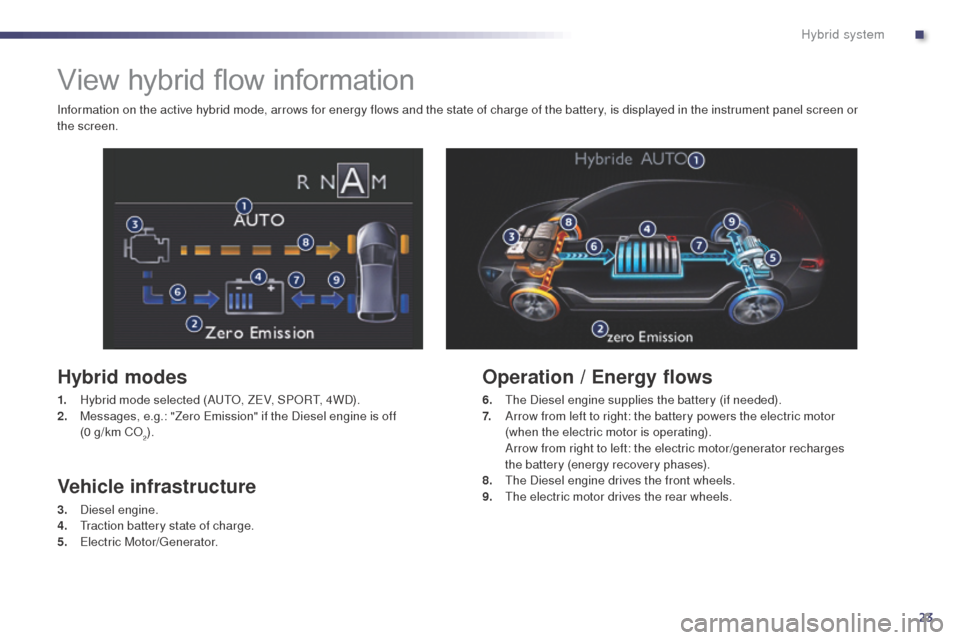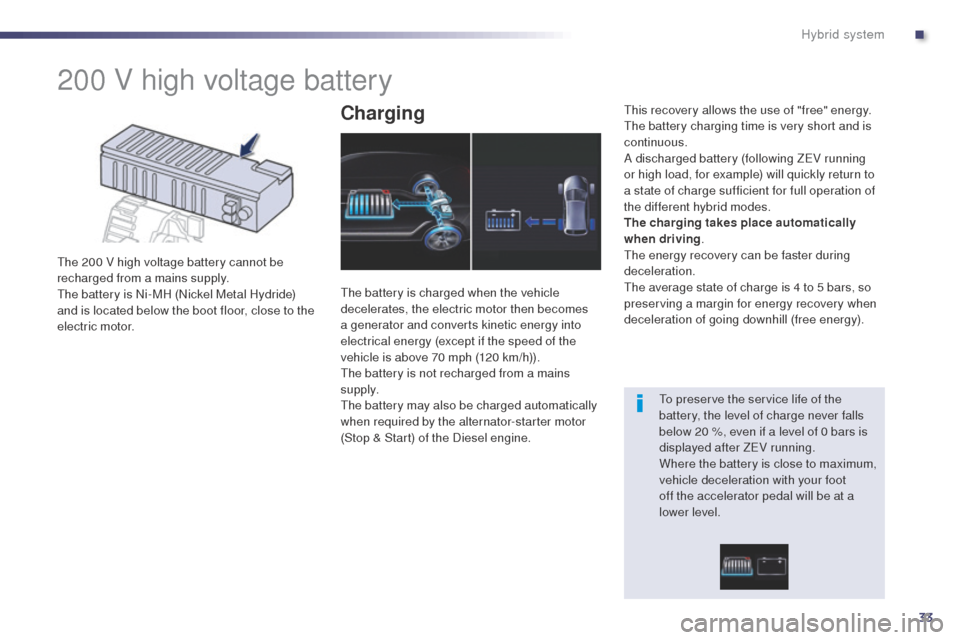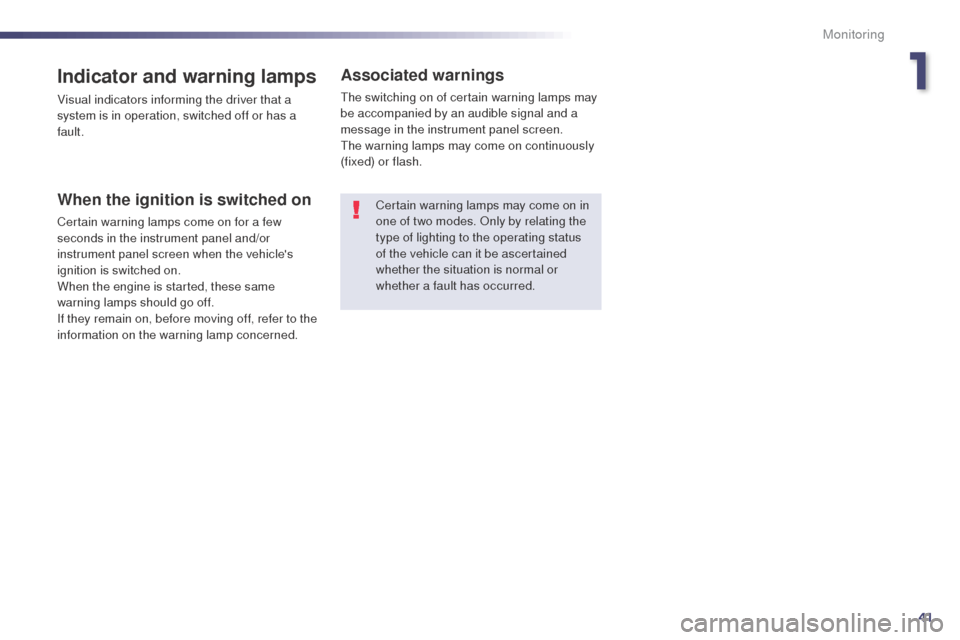2014 Peugeot 508 RXH ECO mode
[x] Cancel search: ECO modePage 25 of 338

23
508RXH_en_Chap00c_systeme-hybride_ed01-2014
View hybrid flow information
Hybrid modes
1. Hybrid mode selected (AutO , ZeV , SPORt, 4 WD).
2. M essages, e.g.: "Zero em ission" if the Diesel engine is off
(0 g/km CO
2).
Vehicle infrastructure
3. Diesel engine.
4. tr action battery state of charge.
5.
e
l
ectric Motor/
ge
nerator.
Operation / Energy flows
6. the Diesel engine supplies the battery (if needed).
7. A rrow from left to right: the battery powers the electric motor
(when the electric motor is operating).
A
rrow from right to left: the electric motor/generator recharges
the
battery (energy recovery phases).
8.
t
he
Diesel engine drives the front wheels.
9.
t
h
e electric motor drives the rear wheels.
Information on the active hybrid mode, arrows for energy flows and the state of charge of the battery, is displayed in the instrument panel screen or
the
screen.
.
Hybrid system
Page 26 of 338

24
508RXH_en_Chap00c_systeme-hybride_ed01-2014
Examples of displays
On starting and when stationary
there is no flow of energy (the Stop & Start system stops and
restarts the Diesel engine automatically).
Energy recovery
During this phase (deceleration, braking, foot off the
accelerator, … all modes), the battery is recharged by the
electric motor/generator, then being driven by the rear wheels.
You can maximise this energy recovery by taking your foot off
the accelerator pedal, deceleration will then be less marked than
with a conventional vehicle.
100% electric
In all electric running (Au tO o r ZeV m odes), only the electric
motor, powered by the battery, drives the rear wheels.
th
e display of "Zero e
m
ission" indicates that the Diesel engine
is off and the vehicle is producing no CO
2.
Hybrid system
Page 27 of 338

25
508RXH_en_Chap00c_systeme-hybride_ed01-2014
Automatic restarting of the Diesel engine or ZEV mode NOT available
the internal combustion engine may restart
or ZeV mode may not be available in the
various conditions presented below.
th
e internal combustion engine can be
switched off automatically as soon as these
conditions are lifted.
When the conditions described below cause
the vehicle to come out of Z
eV m
ode and
the Diesel engine to restart, the vehicle
automatically changes to A
u
t
O m
ode.Difficult weather conditions
and circumstances
- If certain conditions or engine temperature requirements make
it necessary (such as an engine
temperature that is too low for the
ambient conditions).
-
W
hen the battery is close to maximum
charge (for example: when going
down a long hill), because engine
recovery being no longer possible, the
internal combustion engine restarts
automatically just to provide engine
braking.
-
I
f the vehicle encounters a steep slope
(car park ramp, ...).
-
I
f the vehicle has been parked in the sun
for a prolonged period.
-
W
hen driving in mountainous conditions
(altitude).
Your vehicle is fitted with the most effective
emissions control systems, in particular the
Particle Filter (FAP).
At regular intervals your Diesel engine will
produce energy for the self-cleaning of this filter.
During this FAP regeneration phase, electric
running is purposely made unavailable and
is accompanied by a message " Electric
mode not available: FA P regeneration in
progress ".
Maintaining the performance of
the system
- When the vehicle exceeds 18 mph
(30 km/h) after moving off (if the internal
combustion engine has not already
started since the vehicle was last
star ted).
-
I
f the high voltage battery is not
sufficiently charged. A minimum of
4 bars in Z
eV m
ode so as to ensure
operation over a certain distance
(in A
utO
, electric operation is
accessible for a shorter period with a
lower level of charge).
-
W
hen the fuel level enters the reserve
zone (where rate of consumption of
this reserve is high, Z
eV i
nhibition may
continue for some time after refuelling).
-
D
uring regeneration of the particle
filter, which occurs automatically for
5 to 10
minutes, approximately every
300
miles (500 kms) (or less in extended
urban running).
Action by the driver
- Moving the gear selector to position M .
- A ction on steering mounted control
paddles to change gear.
-
S
ustained and sharp acceleration.
-
u
se
of demisting.
-
u
s
e of air conditioning.
.
Hybrid system
Page 28 of 338

26
508RXH_en_Chap00c_systeme-hybride_ed01-2014
HYbrid4 frequently asked questions
ZEV (Zero Emissions Vehicle) mode
QuestionAnswer
Why is it not always possible for me to put the vehicle
into Z
eV (
Zero
e
m
issions Vehicle) mode even though
the battery is well charged?
th
is situation is temporary.
Certain conditions will occasionally prevent the change to Z
eV m
ode, even if the battery
has sufficient charge, such as, for example, very cold conditions, altitude, demisting, high
demand for heating or air conditioning, regeneration of the particle filter (FAP).
Why do I sometimes see an alert message "
el
ectric
mode not available: FAP regeneration in progress"?
th
is is an message relating to the regeneration of the particle filter (FAP). t
h
is is a
completely normal process that takes place every 240 or 300 miles (400 or 500 km)
(or more frequently in prolonged urban use), as on a conventional HDi vehicle.
th
is process is not generally noticed by the driver.
On the other hand, in the case of a hybrid, this phenomenon may be noticeable (in urban
use) as temporarily the HDi engine will not stop and this message will be displayed at
intervals while regeneration is in progress.
Why is it not possible for me to put the vehicle into
Z
eV m
ode, even though I had just been running
electrically in Auto mode?
th
e management of Z
eV i
s different from Auto mode.
Changing to Z
eV m
ode is only possible with a battery charge of at least 4 bars, in order to
assure sufficient range.
In Auto mode, the system alone manages the conditions for changing temporarily to electric
mode, for shorter periods and with a lower state of charge of the battery.
Why is the range in Z
eV (
Zero e
m
issions Vehicle)
mode lower when climbing?
th
e vehicle needs more energy when climbing than when running on the level.
So it is better to stay in Auto mode, which will favour operation of the Diesel engine.
Why is it that the system makes me come out of Z
eV
(
Zero
e
m
issions Vehicle) mode; it does not return to
Z
eV a
utomatically when the conditions allow? It is not intended to give preference to Z
eV r
unning at any cost, as it is not always the most
economical mode.
So the system returns automatically to Auto mode.
Hybrid system
Page 29 of 338

27
508RXH_en_Chap00c_systeme-hybride_ed01-2014
Reducing consumption - Fuel
QuestionAnswer
How can I optimise my fuel consumption?
gi
ve preference to Auto mode as it selects in the best way the "driving energy source" to
use in order to reduce fuel consumption.
You should also adapt your driving style to the characteristics of hybrid vehicles to get the
best out of it, for example by taking your foot off the accelerator pedal rather than braking
and by anticipating decelerations (entering a built-up area, stop at traffic lights, stop at halt
signs, ...).
Why do I not manage to reduce my fuel consumption
even though I often drive in Z
eV (
Zero e
m
issions
Vehicle) mode? It is not Z
eV m
ode but Auto mode that is the most appropriate for reducing fuel
consumption, as it selects the best "driving energy source".
Z
eV m
ode (100% electric operation) can reduce fuel consumption in some cases. However,
recharging the traction battery has an energy cost.
th
is is why we recommend using Auto mode more often.
Why does the trip computer sometimes display the
bars for 28 mpg (10 litres) consumption in town?
th
e current fuel consumption displayed may appear high when the distance covered is
very low, but this generally has very little impact and the true average fuel consumption will
remain low.
In town, your hybrid retains very good fuel economy (of the order of 35% better than a
non-hybrid vehicle).
Why is my battery rarely fully charged? A partly charged battery is normal operation (4 to 5 bars on average in Auto mode).
th
is allows some capacity to be left free for the recovery for energy when going downhill or
taking when your foot off the accelerator.
Why are there so may fuel alert messages when
starting to use the reserve?
to e
ncourage you to refuel as soon as possible and avoid the loss of hybrid functions.
.
Hybrid system
Page 32 of 338

30
508RXH_en_Chap00c_systeme-hybride_ed01-2014
eco-driving
eco-driving is a range of everyday practices that allow the motorist to optimise their fuel consumption and CO2 emissions.
Eco-driving suited to your
HYbrid4 vehicle
use gear selector position A, as this
optimises gear changes to suit the
circumstances, and the AUTO mode of the
HYbrid4 mode selector.
When moving off, accelerate normally
up to the desired speed ( POWER zone
between 20 and 40 %).
At steady speeds, drive gently with small
movements of the accelerator pedal ( ECO or
CHARGE zone), run in electric mode as often
as possible when driving at low speed.
Anticipate the need to slow down and use
engine braking ( CHARGE zone), so as to
make use of free energy recovery while
keeping light pressure on the accelerator
pedal.
Control the use of your
electrical equipment
Before moving off, if the passenger
compartment is too warm, ventilate it by
opening the windows and air vents before
using the air conditioning.
Above 30 mph (50 km/h), close the windows
and leave the air vents open.
Remember to make use of equipment that can
help keep the temperature in the passenger
compartment down (sun roof and window
blinds...).
Switch off the air conditioning, unless it has
automatic digital regulation, as soon as the
desired temperature is attained.
Switch off the demisting and defrosting
controls, if not automatic.
Switch off the heated seat as soon as possible.
Switch off the headlamps and front foglamps
when the level of light does not require
their
use. Avoid running the Diesel engine when
stationary, particularly in winter; your vehicle
will warm up much faster while driving.
As a passenger, if you avoid connecting
your multimedia devices (film, music, video
game...), you will contribute towards limiting
the consumption of electrical energy, and so
of fuel.
Disconnect your portable devices before
leaving the vehicle.
Hybrid system
Page 35 of 338

33
508RXH_en_Chap00c_systeme-hybride_ed01-2014
200 V high voltage battery
the 200 V high voltage battery cannot be
recharged from a mains supply.
th
e battery is Ni-MH (Nickel Metal Hydride)
and is located below the boot floor, close to the
electric motor.
Charging
the battery is charged when the vehicle
decelerates, the electric motor then becomes
a generator and converts kinetic energy into
electrical energy (except if the speed of the
vehicle is above 70 mph (120
km/h)).
th
e battery is not recharged from a mains
supply.
th
e battery may also be charged automatically
when required by the alternator-starter motor
(Stop & Start) of the Diesel engine.
th
is recovery allows the use of "free" energy.
th
e battery charging time is very short and is
continuous.
A discharged battery (following Z
eV r
unning
or high load, for example) will quickly return to
a state of charge sufficient for full operation of
the different hybrid modes.
The charging takes place automatically
when driving .
th
e energy recovery can be faster during
deceleration.th e average state of charge is 4 to 5 bars, so
preserving a margin for energy recovery when
deceleration of going downhill (free energy).
to p
reserve the service life of the
battery, the level of charge never falls
below 20 %, even if a level of 0 bars is
displayed after Z
eV r
unning.
Where the battery is close to maximum,
vehicle deceleration with your foot
off the accelerator pedal will be at a
lower
level.
.
Hybrid system
Page 43 of 338

41
508RXH_en_Chap01_controle-de-marche_ed01-2014
Indicator and warning lamps
Visual indicators informing the driver that a
system is in operation, switched off or has a
fault.
When the ignition is switched on
Certain warning lamps come on for a few
seconds in the instrument panel and/or
instrument panel screen when the vehicle's
ignition is switched on.
When the engine is started, these same
warning lamps should go off.
If they remain on, before moving off, refer to the
information on the warning lamp concerned.
Associated warnings
the switching on of certain warning lamps may
be accompanied by an audible signal and a
message in the instrument panel screen.
th
e warning lamps may come on continuously
(fixed) or flash.
Certain warning lamps may come on in
one of two modes. Only by relating the
type of lighting to the operating status
of the vehicle can it be ascertained
whether the situation is normal or
whether a fault has occurred.
1
Monitoring